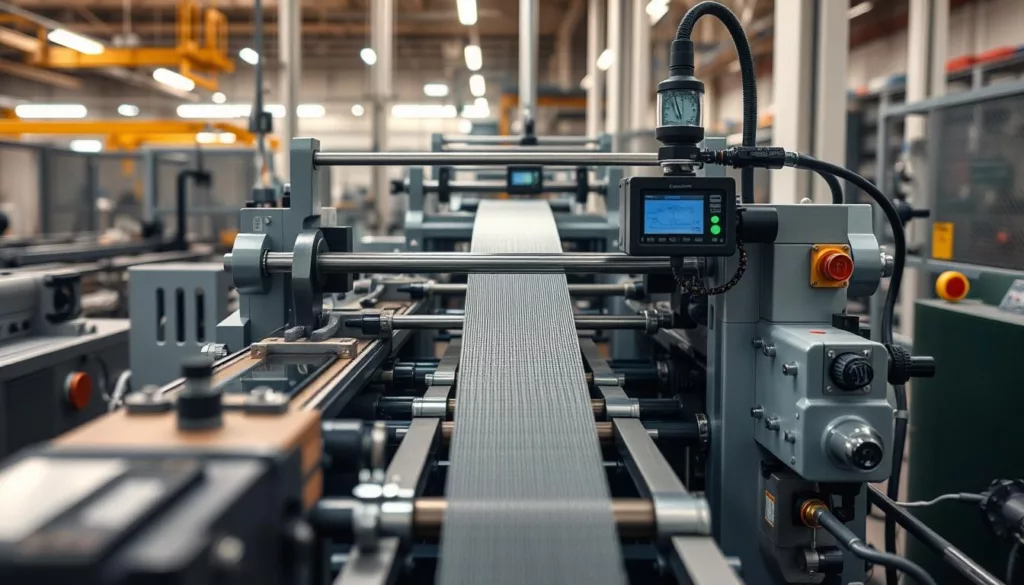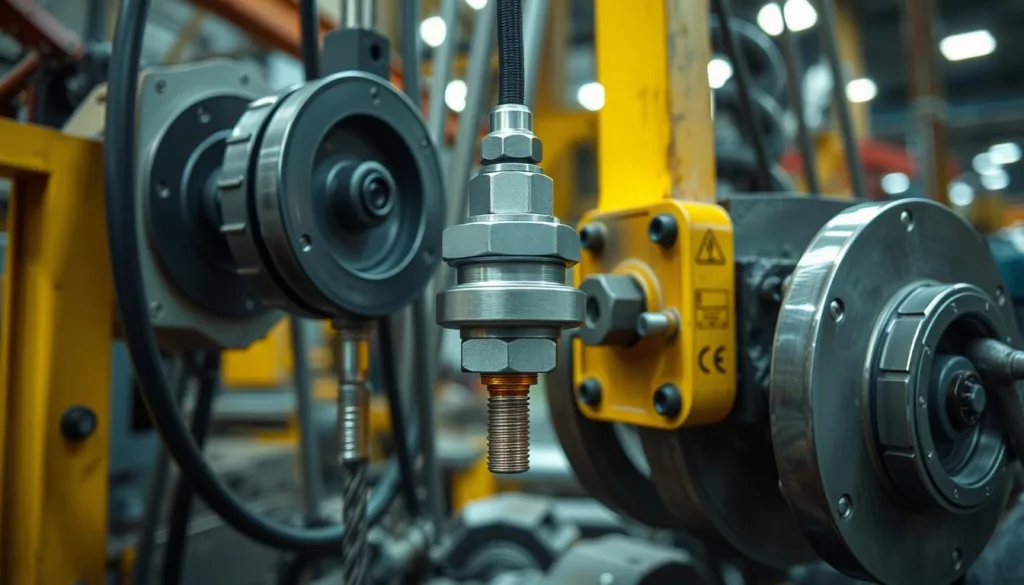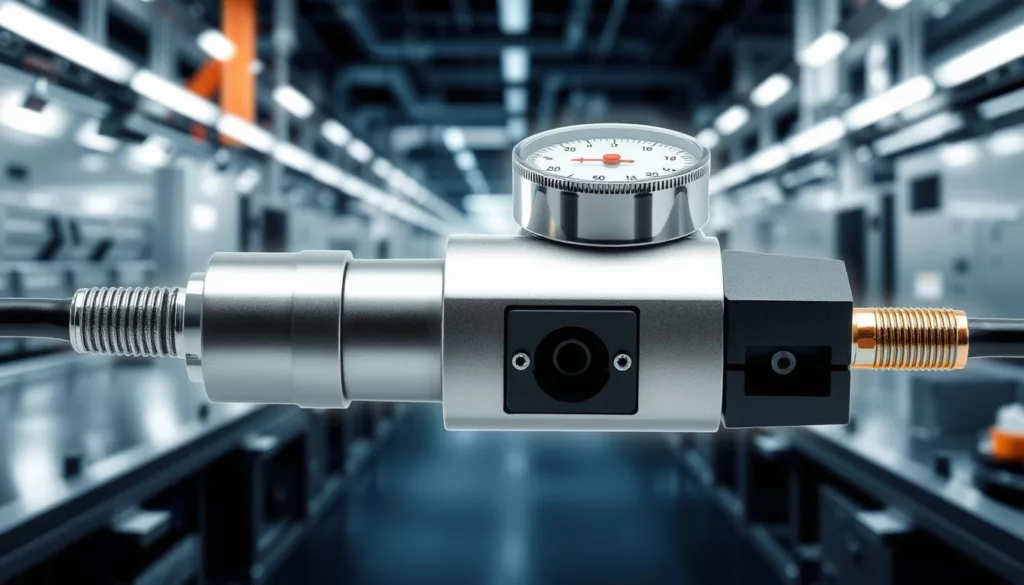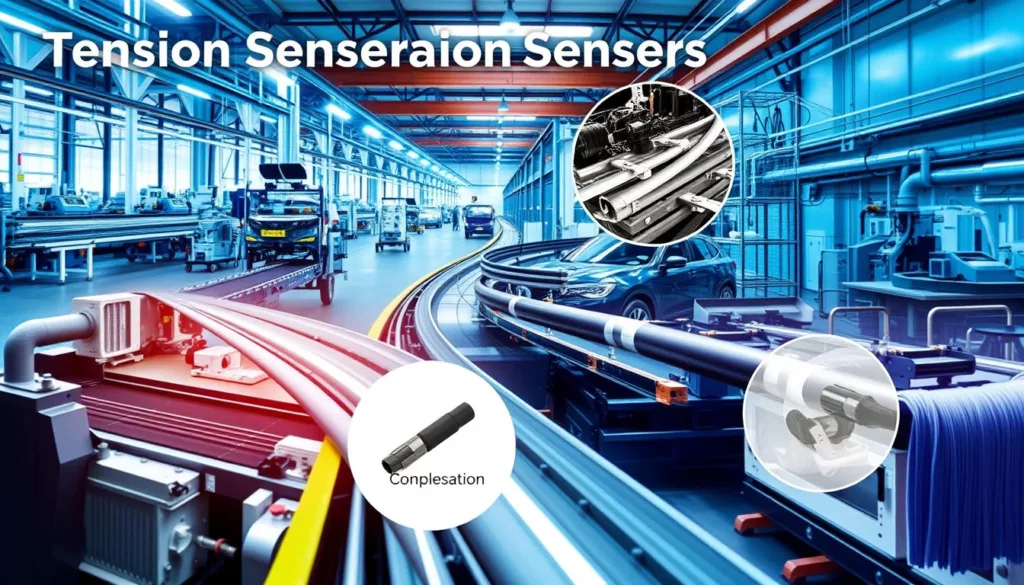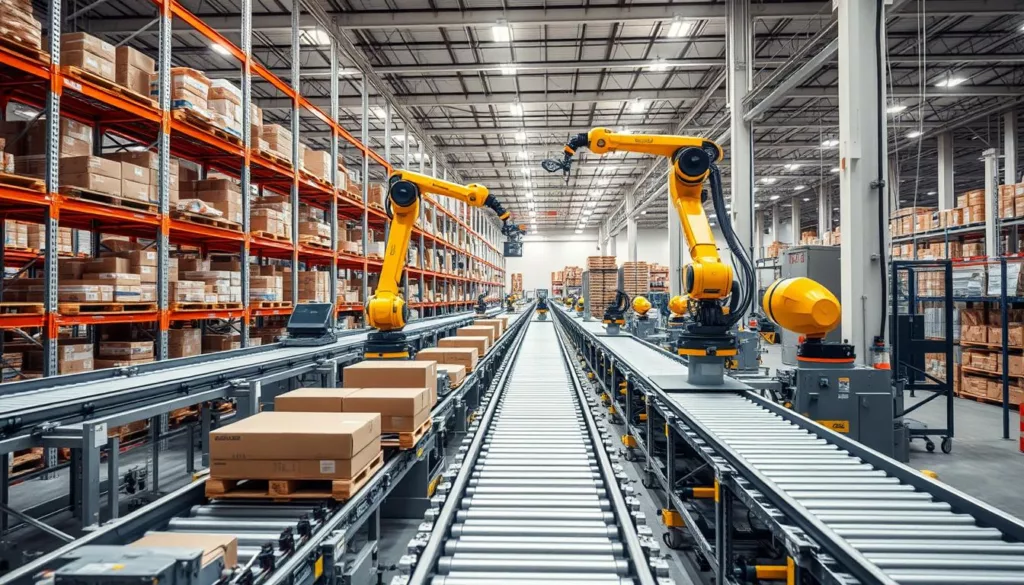Tension sensors, also known as load cells or force transducers, are key in many industrial processes. They help control and monitor material tension precisely. These devices are vital for smooth and efficient manufacturing, from handling webs and packaging to processing materials and assembling lines.
At the heart of a tension sensor’s work is its ability to measure force or tension on materials. This could be on a conveyor belt, fabric, paper, or other flexible materials. By turning this force into an electrical signal, tension sensors offer real-time data. This data helps improve production, cut down on waste, and enhance product quality.
In this article, we’ll explore how tension sensors work. We’ll look at their basic principles, the types of sensing elements, and their use in different industrial settings. Knowing how tension measurement works can help professionals improve their manufacturing processes and stay competitive.
Key Takeaways
- Tension sensors, or load cells, convert physical force into electrical signals to enable precise tension monitoring in industrial applications.
- These devices play a critical role in optimizing manufacturing processes, reducing waste, and improving product quality.
- Understanding the principles and components of tension sensors is essential for leveraging their full potential in industrial settings.
- Effective integration of tension sensors can enhance material handling, web control, and conveyor belt operations.
- Advancements in digital signal processing and smart diagnostics are driving the evolution of tension sensing technology.
Understanding Tension Sensors: Basic Principles and Functions
Tension sensors are key in today’s industries. They help control web tension, manage materials, and monitor processes. Let’s explore how these sensors work and their importance.
Force Detection Mechanisms
Tension sensors use different ways to measure tension. Strain gauge sensors track material deformation. Piezoelectric sensors create an electrical signal when stressed. Capacitive sensors notice changes in electrical fields due to tension.
Signal Processing and Output Generation
After detecting tension, sensors process the signals. They convert these into useful data. This involves converting analog signals to digital, amplifying, and using digital processing for accurate measurements.
Types of Sensing Elements
- Strain gauge-based sensors
- Piezoelectric sensors
- Capacitive sensors
- Customized force transducers
XJCSENSOR is a top force sensor maker. They create sensing elements for various industrial needs. Their focus on precision and reliability helps industries control tension accurately.
“XJCSENSOR’s commitment to innovation and technical excellence ensures our customers receive the most advanced tension sensing solutions for their industry-specific needs.”
How Does a Tension Sensor Work in Industrial Applications?
In the world of industrial automation, tension measurement is key. It ensures precision, efficiency, and quality. Tension sensors are the heroes, keeping tension levels perfect in many manufacturing steps. Let’s explore how they help industrial automation and precision engineering systems work smoothly.
Tension sensors detect and measure force on materials or objects. They use strain gauges or load cells to do this. These parts turn the force into an electronic signal.
When something is under tension, the sensor measures the force. It then sends this information as a digital signal to the control system.
- The sensor’s parts, like flexures or diaphragms, bend with the tension. This bending creates an electrical signal.
- Some advanced sensors use digital signal processing. This makes their measurements even more accurate and reliable.
- The sensor sends its output to the control system. Here, it helps make adjustments to keep tension levels right during production.
Tension sensors are vital for keeping product quality and performance steady. They’re used in many industries, like textiles, paper, and metals. These devices help keep production running smoothly and reduce waste or downtime.
“Tension sensors are the unsung heroes of industrial automation, ensuring precision, efficiency, and quality in a wide range of manufacturing processes.”
The need for industrial automation and precision engineering is rising. So is the need for accurate tension measurement. Knowing how tension sensors work helps professionals use these technologies to boost productivity and success.
Key Components and Architecture of Modern Tension Sensors
Every reliable tension monitoring system has core components that work together. They deliver precise and consistent measurements. The architecture of modern tension sensors is designed for optimal performance and quality control.
Mechanical Elements
The mechanical foundation of tension sensors includes load cells or force transducers. These elements convert physical forces into electrical signals. They are precisely engineered to respond to specific force or displacement parameters, ensuring accurate and repeatable readings.
Electronic Components
The electrical and digital systems within tension sensors handle signal processing, amplification, and communication. Advanced electronic components like microcontrollers and analog-to-digital converters integrate mechanical measurements with intuitive user interfaces and control systems.
Calibration Systems
- Precision calibration is key for maintaining quality control of tension monitoring data.
- Integrated calibration mechanisms, such as reference springs or shunt resistors, allow for regular adjustments. This ensures consistent, reliable measurements.
- Calibration routines can be automated or performed manually, depending on the specific industrial application.
Understanding the key components and architectural design of modern tension sensors is vital. It ensures optimal performance, data integrity, and operational efficiency in material handling and production processes.
Applications Across Different Industrial Sectors
Tension sensors are key in many industries, helping keep product quality high and operations running smoothly. They are used in sectors like textiles, paper, metal processing, and packaging. These devices are versatile and play a big role in each area.
In the textile world, tension sensors watch over web tension in spinning, weaving, and finishing. They help make sure fabric quality stays consistent, cut down on waste, and boost productivity. Paper makers use them too, to keep the web tension just right. This stops problems like wrinkles, tears, or uneven coating during printing and converting.
The metal processing industry also relies on tension sensors. They check and control metal coil, sheet, and strip tension. This ensures even thickness and prevents defects in rolling, stamping, or cutting. It leads to better product quality and less material waste.
In packaging, tension sensors are vital for material handling systems. They track tension in conveyor belts, film, and other flexible packaging. This allows for precise control and better packaging. It keeps products safe, reduces waste, and makes operations more efficient.
Across these different sectors, tension sensors are a must for industrial automation and material handling systems. They help with web tension control, improve product quality, and increase productivity.
“Tension sensors are the unsung heroes of industrial processes, ensuring consistent quality and optimal efficiency across a wide range of manufacturing sectors.”
Integration with Material Handling Systems
Tension sensors are key in making material handling efficient in many industries. They help control web tension in paper making and monitor conveyor belts in logistics. These sensors ensure materials flow well, reduce waste, and keep product quality steady.
Web Tension Control
In paper, film, and textile making, keeping web tension right is critical. Tension sensors along the web path give real-time data. This lets operators adjust tension for the best results, avoiding web breaks and improving product quality.
Conveyor Belt Applications
Tension sensors also keep conveyor belts running smoothly. They spot issues like belt slippage or wear early. This helps avoid costly downtime and keeps product quality high.
Winding and Unwinding Operations
Winding and unwinding processes need tension sensors too. They keep the right tension to avoid damage to materials. This ensures the product’s quality and stability, boosting manufacturing efficiency.
Adding tension sensors to material handling systems boosts monitoring and quality control. This leads to better performance and outcomes for businesses.
Benefits of Tension Monitoring in Manufacturing
Tension monitoring is key in industrial automation and quality control. It helps manufacturers improve their workflows and efficiency. By using tension sensors, they can make their production better.
One big plus of tension monitoring is keeping product quality steady. Sensors track the force on materials, spotting any issues fast. This stops bad products, cuts down on waste, and makes customers happy.
Tension monitoring also helps in making processes better. By looking at tension data in real time, manufacturers can tweak their operations. This makes them more productive, cuts downtime, and boosts equipment use.
| Benefits of Tension Monitoring | Impact on Manufacturing |
|---|---|
| Consistent product quality | Reduced waste and returns, improved customer satisfaction |
| Process optimization | Increased productivity, reduced downtime, enhanced OEE |
| Predictive maintenance | Longer equipment lifespan, fewer unexpected breakdowns |
Also, tension monitoring helps predict when equipment might fail. This lets manufacturers fix problems before they cause big issues. Keeping equipment in good shape saves money and reduces downtime.
In short, using tension monitoring systems in manufacturing brings many benefits. It improves quality control and process optimization. It also boosts industrial automation and maintenance. Companies that use these technologies can work more efficiently, save money, and stay competitive.
Advanced Features in Modern Tension Sensors
Tension sensors are getting smarter with new technologies. They now offer more value to businesses in industrial automation, precision engineering, and quality control. Let’s look at some of these new features.
Digital Signal Processing
Analog signal processing is old news for tension sensors now. Today, they use digital signal processing (DSP) for better accuracy and speed. DSP turns analog signals into digital ones for deeper analysis and quicker fixes.
Remote Monitoring Capabilities
Modern tension sensors can now connect to remote monitoring systems. They use wireless tech and cloud platforms to send data to control rooms or phones. This lets engineers and operators check system status and make decisions from anywhere.
Smart Diagnostics
Tension sensors now have advanced diagnostic tools. They can check their own health and performance. Smart algorithms spot problems early and give maintenance teams tips to keep things running smoothly.
These new features make modern tension sensors more accurate and reliable. They make quality control and work efficiency better than ever.
Installation and Maintenance Best Practices
When it comes to tension measurement, installing and maintaining your [tension sensors](https://www.xjcsensor.com/differences-between-strain-gauges-and-force-sensors/) right is key. Experts in load cells and [force transducers](https://www.xjcsensor.com/differences-between-strain-gauges-and-force-sensors/) share best practices. These tips will help you get the best out of your tension sensing equipment.
- Careful Placement: Place your tension sensors away from things that might mess with them, like vibrations or temperature changes.
- Proper Mounting: Make sure your sensors are securely attached to the structure. Follow the manufacturer’s instructions to avoid problems later.
- Calibration Routines: Keep your sensors calibrated to stay accurate. Adjust them as needed to keep precision high.
- Proactive Maintenance: Check your sensors for damage or wear. Clean them as needed to stop contaminants from building up.
- Environmental Considerations: Make sure your sensors can handle the environment they’ll be in. This includes things like temperature and humidity.
| Best Practice | Description | Benefits |
|---|---|---|
| Careful Placement | Position sensors to minimize interference | Improved accuracy and reliability |
| Proper Mounting | Secure sensors according to manufacturer guidelines | Prevent misalignment and slippage |
| Calibration Routines | Regularly calibrate sensors to maintain precision | Ensure consistent, reliable measurements |
| Proactive Maintenance | Inspect and clean sensors to prevent contamination | Extend sensor lifespan and performance |
| Environmental Considerations | Use sensors rated for specific operating conditions | Prevent premature wear or failure |
By following these best practices for tension measurement, you can make your [load cells](https://www.xjcsensor.com/differences-between-strain-gauges-and-force-sensors/) and [force transducers](https://www.xjcsensor.com/differences-between-strain-gauges-and-force-sensors/) more accurate and last longer. This is true for many industrial uses.
“Proper installation and maintenance are the foundation for achieving accurate, long-lasting tension measurement in any industrial setting.”
Future Trends in Tension Sensing Technology
The world of industrial automation and precision engineering is always changing. New advancements in sensor design and process monitoring systems are on the horizon. These changes will make tension measurement more accurate, reliable, and flexible.
Another exciting trend is the connection of tension sensors with the Industrial Internet of Things (IIoT) and cloud-based analytics. This will allow for real-time monitoring and predictive maintenance. It will also help in optimizing processes, improving equipment effectiveness (OEE) and production efficiency.
Artificial intelligence (AI) and machine learning will also play a big role in tension sensing. These technologies will help manufacturers understand and use data better. They will be able to spot small changes, prevent problems, and make smart decisions to improve their operations.

